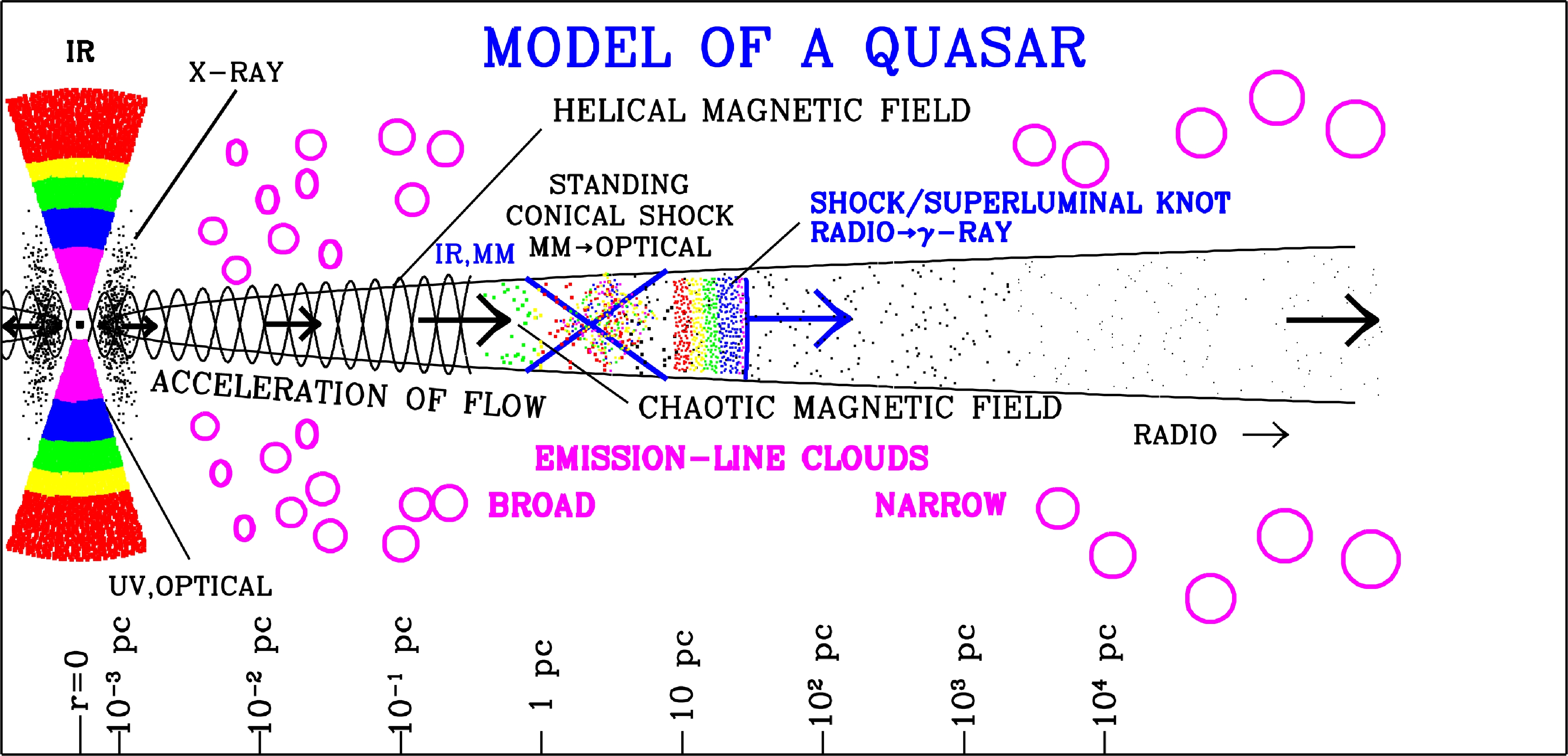

Frame from a conceptual animation of 3C 120 created by COSMOVISION
Below: Sketch of the structure and locations of emission at different wavebands in a quasar/active galactic nucleus (AGN), created by A. Marscher. In the quasar case, the jet points almost toward us. In the AGN sketch, the jet is viewed at a wider angle, so it is more of a side view. The small dot at the center of the disk represents a supermassive black hole. The colors signify "frequency stratification" of the emission. The highest-frequency synchrotron emission requires the highest energy electrons, which are found only very close to the location where they were energized, since they lose energy rapidly by emitting radiation. The accretion disk (which extends above and below the black hole in the sketch) is hotter closer to the black hole, so its thermal emission peaks at higher frequencies closer to the black hole.


The Boston University Blazar Group maintains a vigorous research program that explores the nonthermal emission from the relativistic jets of blazars. For an introduction to quasars, blazars, and the group's research program, view Alan Marscher's presentation of January 29, 2002 (PDF format) at the Boston University Department of Physics colloquium. The research of the Blazar Group is funded by the National Science Foundation (see statement and disclaimer below) and NASA.
At a meeting in December 2005 at the University of Michigan, Alan Marscher opened the conference with a review talk on properties of the jets in active galactic nuclei that can be compared with microquasars (systems in our Galaxy containing a black hole and a star orbiting close to it that display jets and other phenomena similar to blazars) and gamma-ray bursts (thought to be caused by the birth of a black hole). You can download the slides from the talk in Mac PowerPoint or PDF format. A paper that appears in the proceedings of the conference, published in volume 856 of the American Institute of Physics conference series, can be downloaded in PDF format as well. At a conference in June 2006 in St. Petersburg, Russia, Marscher gave a talk on progress in our understanding of active galactic nuclei in Russian. This is also available in Mac PowerPoint or PDF format.
Note: All images, movies, and figures presented here are copyrighted by Alan Marscher, Svetlana Jorstad, et al., Jose Luis Gomez et al., or Wolfgang Steffen (the animations of 3C 120 by COSMOVISION). Any use of these images (other than viewing) requires written permission by the authors. Send such requests to Alan Marscher except for the COSMOVISION images and movies, for which the contact is Wolfgang Steffen.
Multifrequency Observations of Blazars
Theoretical Models for Multifrequency Variability
Variability
of the Nonthermal Emission in Relativistic Jets
Publications of the BU Blazar Group
This material is based upon work supported in part by the National Science Foundation under grant numbers AST-980294, AST-0098579, and AST-0406865. Any opinions, findings, conclusions, or recommendations expressed in this material are those of the authors and do not necessarily relect the views of the NSF. The research is also supported by a number of grants from NASA. In addition, the NSF and NASA fund and supervise the operation of many of the telescopes involved in the observations.
Back to the blazar group's home page
Go to the personal web pages of: Alan Marscher ---- Svetlana Jorstad ---- Nicholas MacDonald